
The University of North Georgia (UNG) is one of three National Collegiate Athletic Association (NCAA) Division II schools to recently join a national initiative that aims to prevent, diagnose and treat concussions.
The $30 million initiative pairs the NCAA and the Department of Defense (DOD), and now includes 30 institutions of higher education across the country. The collective is titled the Concussion Assessment, Research and Education (CARE) Consortium. The nine recent additions announced earlier this month — including UNG — will begin adding their data to the study this summer.
“UNG is honored to be chosen as a participant in this landmark concussion study,” said Director of Athletics Lindsay Reeves. “Student-athlete welfare is paramount in our mission at UNG, so we are glad that we can assist with this important research initiative and return-to-play protocols.”
To participate in the study, all UNG student-athletes receive a full preseason evaluation for concussions with follow-up checks in the event of an injury. The collected data will be sent to a team of researchers for tracking and study.
So far, more than 25 million data points from 16,000 student-athletes have been collected from the 21 institutions already participating. With the nine additional sites, researchers estimate that more than 25,000 student-athletes will participate during the three-year study.
“The important expansion of the CARE Consortium to include a diversity of Division I, Division II, Division III and historically black college and university participants further solidifies this study as a groundbreaking initiative,” said Brian Hainline, NCAA chief medical officer. “It is a remarkable collaborative and inclusive effort.”
The NCAA and DOD have dedicated $30 million to the concussion study and to an initiative to spur culture change regarding concussion. Participating schools receive a portion of that funding to cover the cost of carrying out the research.
According to Matt Daniel, head athletic trainer at UNG, national interest in concussion treatment and prevention has gained momentum in the past few years due to leaps in knowledge and understanding of how the injuries present in athletes.
“Concussions are very difficult to evaluate and identify; each situation, injury and athlete is different. Recovery rates are also different for each person and each event,” Daniel said. “The brain heals very slowly, so it is critical that we prevent or correctly diagnose concussions as often as possible. We are becoming more educated about how severely effects can present and how they can impact the individual. The more we as athletic trainers and medical professionals learn, the more our society learns and becomes interested in supporting these initiatives.”
Daniel said that problems after a concussion occurs can present hours or days after the injury happens. In an effort to protect UNG student-athletes, one portion of the university’s concussion protocol includes online cognitive baseline testing, to help athletic trainers establish how the university’s student-athletes function when they are injury-free. This gives them data for comparison if a student-athlete suffers a head injury.
“If someone is injured and we must do a sideline examination, we have a return-to-play protocol that mandates the student-athlete must undergo more cognitive tests to make sure they meet or exceed the baseline scores that he or she achieved before beginning the season. We are very thorough in our examinations; we also have a team neurologist 20 minutes away in case an emergency ever arises.”
Numbers vary, but UNG athletics typically diagnoses about 10 concussions per year among its more than 225 student-athletes. According to data collected by the CARE consortium, an estimated yearly average of 10,500 college athletes have sustained concussions for the past five years, and more than 320,000 brain injuries have been reported among American service members since 2000.
CLICK HERE FOR ORIGINAL ARTICLE

